人教版高中英语必修四第五单元阅读课课件Unit Theme arks
- 格式:ppt
- 大小:1.27 MB
- 文档页数:32
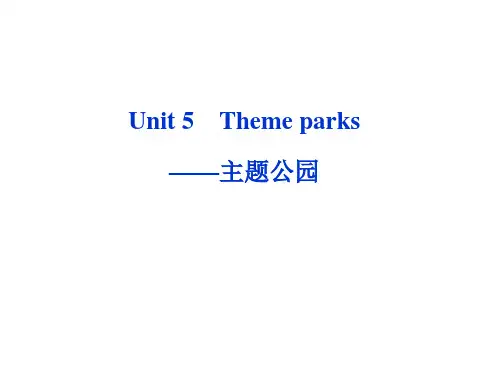
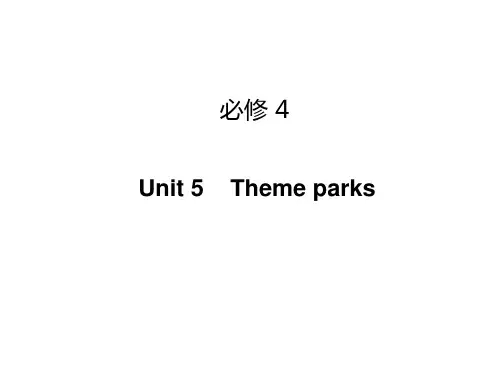
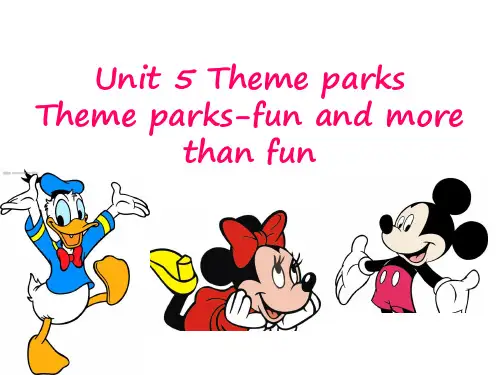
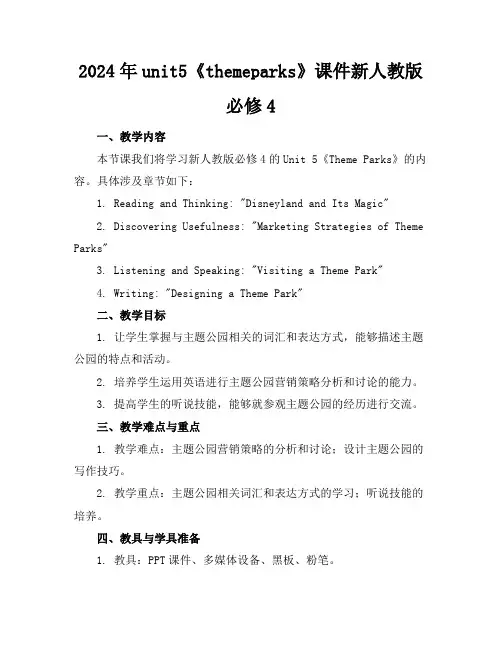
2024年unit5《themeparks》课件新人教版必修4一、教学内容本节课我们将学习新人教版必修4的Unit 5《Theme Parks》的内容。
具体涉及章节如下:1. Reading and Thinking: "Disneyland and Its Magic"2. Discovering Usefulness: "Marketing Strategies of Theme Parks"3. Listening and Speaking: "Visiting a Theme Park"4. Writing: "Designing a Theme Park"二、教学目标1. 让学生掌握与主题公园相关的词汇和表达方式,能够描述主题公园的特点和活动。
2. 培养学生运用英语进行主题公园营销策略分析和讨论的能力。
3. 提高学生的听说技能,能够就参观主题公园的经历进行交流。
三、教学难点与重点1. 教学难点:主题公园营销策略的分析和讨论;设计主题公园的写作技巧。
2. 教学重点:主题公园相关词汇和表达方式的学习;听说技能的培养。
四、教具与学具准备1. 教具:PPT课件、多媒体设备、黑板、粉笔。
2. 学具:课本、笔记本、字典。
五、教学过程1. 导入:通过展示一些国内外知名主题公园的图片,引导学生谈论他们对主题公园的了解和印象。
2. 新课内容呈现:a. 阅读文章"Disneyland and Its Magic",学习主题公园相关词汇和表达方式。
b. 分析讨论主题公园的营销策略。
c. 听力练习"Visiting a Theme Park",提高听说技能。
d. 课堂活动:小组讨论,设计一个主题公园。
3. 例题讲解:针对写作部分"Designing a Theme Park",给出示例并进行分析。


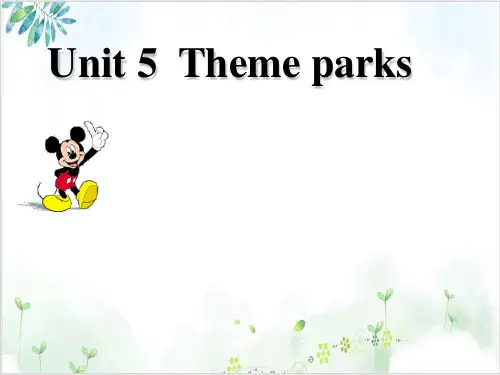
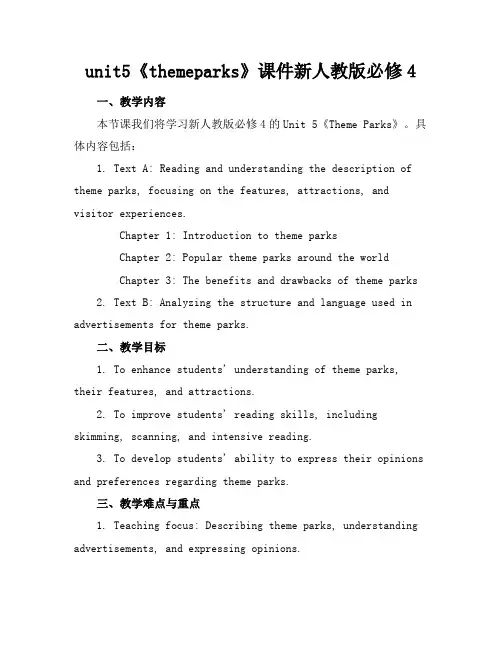
unit5《themeparks》课件新人教版必修4一、教学内容本节课我们将学习新人教版必修4的Unit 5《Theme Parks》。
具体内容包括:1. Text A: Reading and understanding the description of theme parks, focusing on the features, attractions, and visitor experiences.Chapter 1: Introduction to theme parksChapter 2: Popular theme parks around the worldChapter 3: The benefits and drawbacks of theme parks2. Text B: Analyzing the structure and language used in advertisements for theme parks.二、教学目标1. To enhance students' understanding of theme parks, their features, and attractions.2. To improve students' reading skills, including skimming, scanning, and intensive reading.3. To develop students' ability to express their opinions and preferences regarding theme parks.三、教学难点与重点1. Teaching focus: Describing theme parks, understanding advertisements, and expressing opinions.2. Teaching difficulties: Mastering the vocabulary related to theme parks and using appropriate language to express preferences.四、教具与学具准备1. Teaching materials: PowerPoint slides, handouts with vocabulary lists, reading texts.2. Learning materials: Notebooks, dictionaries, and textbooks.五、教学过程1. Introduction (5 minutes):Present a reallife scenario: Imagine planning a trip to a theme park.Engage students in a brief discussion about their experiences and favorite theme parks.2. Reading Text A (15 minutes):a. Skimming: Students quickly read the text to grasp the main idea.b. Scanning: Students find specific information about theme park features and attractions.c. Intensive reading: Analyze the structure and language used in the text.3. Vocabulary Practice (10 minutes):Present new vocabulary related to theme parks.Conduct interactive activities to reinforce vocabulary understanding.4. Reading Text B (15 minutes):Analyze the structure and persuasive language used in theme park advertisements.Discuss the benefits and drawbacks mentioned in the advertisements.5. Group Discussion (10 minutes):Divide students into groups and ask them to discuss their opinions on theme parks.Encourage them to use the vocabulary learned during the discussion.6. Presentation (10 minutes):Each group presents their opinions, supported reasons and examples from the texts.六、板书设计1. Main headings: "Features of Theme Parks," "Popular Theme Parks," "Advertisements," "Opinions and Preferences."2. Key vocabulary: List important words and phrases related to theme parks.3. Structured notes: Outline the structure of the texts and advertisements.七、作业设计1. Comprehension Questions:What are the main features of theme parks?How do advertisements persuade visitors to visittheme parks?2. Essay Writing:Write an essay expressing your opinion on theme parks, including reasons and examples.(Answer Key: Provided with detailed feedback on content, organization, and language use.)八、课后反思及拓展延伸1. Reflection: Assess students' engagement, understanding, and participation during the lesson. Identify areas for improvement.2. Extension: Encourage students to research a specific theme park and create their own advertisement, incorporating persuasive language and highlighting unique features. Present these advertisements in the next class for peer evaluationand discussion.重点和难点解析1. 教学目标中的阅读技能提升2. 教学难点:主题公园相关词汇的掌握和表达偏好3. 教学过程中阅读策略的应用4. 作业设计中的论述题写作一、教学目标中的阅读技能提升1. Skimming(快速阅读):学生通过快速阅读,抓住文章的主旨大意。

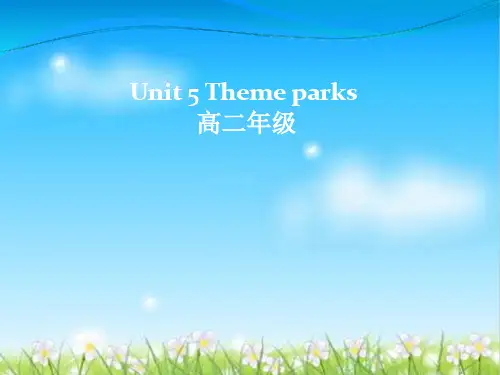
![高一英语人教课标必修4 Unit 5 Theme Parks Reading[] PPT课件 图文](https://uimg.taocdn.com/d49c3551cc7931b764ce1520.webp)